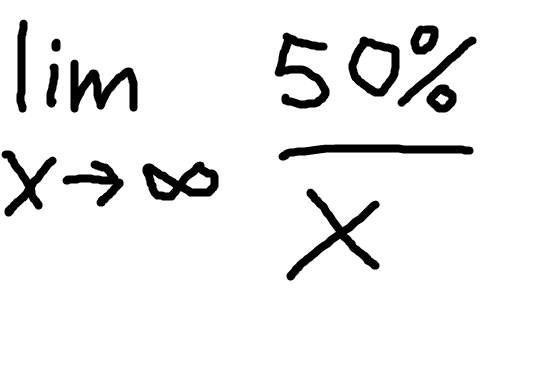I was going through some problems, thought I'd post some of the problems which the answers don't require a very mathy solution:
fuck if i know
number 4 is the only interesting question the rest are trivial/dumb
so assuming 50% of getting boy/girl
if they get a girl, stop immediately
chance to get 1 boy: 50% for a boy, 50% for a girl
chance to get 2 consecutive boys: 50% * 50% = 25% for 2 boys, 75% for at least 1 girl
chance to get 3 consecutive boys: 12.5% for 3 boys, 87.5% for at least 1 girl
4 consec boys: 6.25%, 93.75% for at least 1 girl
etc.
so a couple can go on an unlimited streak of boys, but they can't go on an unlimited streak of girls (since it ends on the first one)
50% for 1 boy
25% for 2 boys (the percentage gets divided by 2, while number of boys gets multiplied by 2)
12.5% for 3 boys (percentage gets divided by 4 (from the start), while number of boys gets multiplied by 4
so the function is f(x) = 50% / x i think? but then im not sure how u solve it, in like, finding estimate number of average X if u rand it 1000 times or something
i think ur supposed to use that
lim something somethign thingy
x->ifninity
I don't think any are trivial. #1 you prob can't even solve if you don't know binary.
#2 I got completely wrong
If you think 1-3 are trivial I'm surprised you don't think #4 is equally trivial because if you play out the numbers you'll get to your answer rather easily assuming an equal probability exists for getting either a boy or girl.
for 1 dont you just ... throw the die? i dont get it?
for 2 how is it a math question? isnt it like a trick question, one of those "100 bets you'll never lose at a bar !!" things?
and for 3 its jsut 50%

@iaafr is there a way to solve this or is this the answer?
If you have a 6 sided die, how do you throw the die in such a way that you can roll a number between 1-7 with equal probability?
Like throwing the die by itself has equal chance to land 1-6 but you need to find a way to throw it that you can count to 1-7
Lmao you got them all wrong. The coin one isn't a trick question at all.
None of these are trick questions and it isn't 1/2 for #3
i thought 1 and 7 exlucded. ok if they're included then:
2 extra numbers than the usual 6. so 33% increase. u can calcualte it with a die throw
2 numbers, one higher, one lower. 50/50, u can calcualte with a die throw
so u do this:
throw the die. if its 1, 2, 3, 4 => throw it again, and whatever u throw, thats the number. from 2 to 6.
if u roll 5 or 6, then throw again
if u roll 1, 2, or 3 => ur ending number is 1
if u roll 4, 5, 6 => ur ending number is 7
For #1 you need to find a system of throwing the die that let's you go up to 1-7, and I already hinted it requires you to know how to count in binary.
#2 say you have a coin that flips heads 9/10 times and tails 1/10 times, or some other value like 67/70 heads vs 3/70 tails, how do you flip the coin in such a way that the result is a 'fair' 50/50 between two players?
#3 it's not 1/2 lol, my hint is that you don't know if the first or second kid is a girl, so you need to imagine every possible scenario and pick from the ones which the question narrows down for you and then calculate the probability
#4 if you had 1000 couples and they had kids, try to imagine how it would play out and what the distribution might look like
well thats different. i was assuming a real-life scenario where some guy hands u a coin and u dont know how much is one side heavier than the other
and for number 3 its very obviously 50/50 lol
the image you posted is a trivial limit of the function 0.5/x as x goes towards infinity and it clearly = 0
unlikely this limit is involved in any solution
Based on the system you created, does each number have an equal chance of occurring like in the situation with the 1-6 die?
yea i think so
how is the answer to 3 not 50/50
there are 2 possibilites: girl/boy and girl/girl, lol
i dont even consider 3 a well formed question
looked up the answer to 2 and its pretty clever tho
wait i forgot how dies work. they count from 1-6. i thought they count from 2-6 i forgot they have the 1 oops
nvm
How many times can you roll the die?
For #1 just use a d7 die from D&D. Otherwise just have each number on the die represent a bit positions 1 2 3, and 4 5 6 also correspond to 1 2 3. Then roll it 3 times?